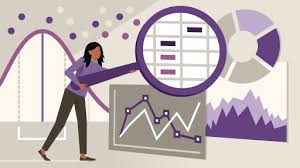
Unveiling the Impact: Statistics in Modern Society
The Power of Statistics: Understanding Data in the Modern World
Statistics play a crucial role in shaping our understanding of the world around us. From predicting trends to making informed decisions, statistical data provides valuable insights that drive progress and innovation.
One of the key benefits of statistics is its ability to simplify complex information into meaningful patterns and trends. By analyzing data sets, statisticians can identify correlations, outliers, and probabilities that help us make sense of seemingly random phenomena.
Statistics are used in a wide range of fields, including science, business, healthcare, and social sciences. In medicine, statistics help researchers evaluate the effectiveness of treatments and assess health outcomes. In business, statistical analysis guides marketing strategies and financial planning. In social sciences, statistics inform policy decisions and societal trends.
Understanding statistics is essential for making informed decisions in a data-driven world. By interpreting statistical data accurately, we can avoid common pitfalls such as misinterpretation or bias. Statistical literacy empowers individuals to critically evaluate information and draw reliable conclusions based on evidence.
As technology advances, the importance of statistics continues to grow. Big data analytics, machine learning, and artificial intelligence rely heavily on statistical principles to extract meaningful insights from vast amounts of information. By harnessing the power of statistics, we can unlock new possibilities for innovation and problem-solving.
In conclusion, statistics are a powerful tool for understanding the complexities of our modern world. Whether you are analyzing market trends, conducting scientific research, or evaluating public policies, statistical knowledge is essential for navigating an increasingly data-rich environment.
Understanding Statistics: Key Concepts and Common Questions Answered
- What are the 5 main statistics?
- Is statistics hard or easy?
- What are the 3 types of statistics?
- What is the definition of statistics?
- What is statistics of the study?
- Is statistics a hard class?
- What are three types of statistics?
- What is the simple definition of statistics?
What are the 5 main statistics?
The five main statistics commonly referred to in data analysis are mean, median, mode, range, and standard deviation. These statistical measures provide valuable insights into the central tendencies, variability, and distribution of a dataset. The mean represents the average value of a set of numbers, the median is the middle value when the data is ordered, and the mode is the most frequently occurring value. The range indicates the difference between the highest and lowest values in a dataset, while the standard deviation quantifies the dispersion of data points around the mean. Understanding and utilizing these key statistics are essential for interpreting and drawing meaningful conclusions from data analysis.
Is statistics hard or easy?
The perception of whether statistics is hard or easy largely depends on individual experiences and perspectives. For some, the mathematical concepts and calculations involved in statistics can be challenging and require a solid understanding of probability theory and data analysis. However, with dedication, practice, and guidance, many people find that statistics becomes more manageable over time. Breaking down complex statistical concepts into smaller, digestible parts and applying them to real-world scenarios can help demystify the subject and make it more approachable. Ultimately, the key to mastering statistics lies in perseverance, patience, and a willingness to learn and grow in statistical literacy.
What are the 3 types of statistics?
In the field of statistics, there are three main types that serve distinct purposes: descriptive statistics, inferential statistics, and exploratory data analysis. Descriptive statistics involve summarizing and presenting data in a meaningful way, such as through measures of central tendency (mean, median, mode) and dispersion (range, variance). Inferential statistics focus on making predictions or inferences about a population based on sample data, using techniques like hypothesis testing and confidence intervals. Exploratory data analysis involves visually exploring data to uncover patterns or relationships that can guide further statistical analyses. Each type of statistics plays a vital role in extracting insights and drawing conclusions from data sets.
What is the definition of statistics?
Statistics is the branch of mathematics that involves collecting, analyzing, interpreting, and presenting data. In essence, statistics provides a framework for understanding and making sense of numerical information to uncover patterns, trends, and relationships within datasets. By applying statistical methods and techniques, researchers and analysts can draw meaningful conclusions, make informed decisions, and derive insights that drive progress in various fields.
What is statistics of the study?
Statistics in a study refer to the quantitative data analysis techniques used to interpret and draw conclusions from the gathered information. It involves collecting, organizing, presenting, and analyzing data to identify patterns, trends, and relationships within the study’s variables. Statistical methods help researchers make sense of complex data sets, test hypotheses, and make informed decisions based on evidence. By applying statistical tools and techniques, researchers can quantify uncertainty, measure the significance of results, and ensure the reliability of their findings in a systematic and objective manner.
Is statistics a hard class?
The difficulty of a statistics class can vary depending on individual learning styles and prior exposure to mathematical concepts. While some students may find statistics challenging due to its emphasis on data analysis and probability theory, others may excel in the subject with proper guidance and practice. Success in a statistics class often hinges on active engagement with the material, seeking help when needed, and applying statistical concepts to real-world scenarios. With dedication and perseverance, students can overcome the perceived difficulty of statistics and develop a strong foundation in this essential field of study.
What are three types of statistics?
In the field of statistics, there are three main types that serve distinct purposes: descriptive statistics, inferential statistics, and exploratory data analysis. Descriptive statistics involve summarizing and presenting data in a meaningful way, such as through measures of central tendency (mean, median, mode) and dispersion (range, variance). Inferential statistics focus on making predictions or inferences about a population based on sample data, using techniques like hypothesis testing and regression analysis. Exploratory data analysis involves uncovering patterns or relationships within a dataset to generate hypotheses for further investigation. Each type of statistics plays a vital role in analyzing and interpreting data to inform decision-making processes across various disciplines.
What is the simple definition of statistics?
Statistics is the branch of mathematics that involves collecting, analyzing, interpreting, and presenting data. In simple terms, statistics provides a framework for understanding numerical information and making informed decisions based on that data. It encompasses methods for summarizing data, drawing conclusions from samples, and quantifying uncertainty in measurements. Essentially, statistics helps us make sense of the world by using numbers to uncover patterns, trends, and relationships within different datasets.

